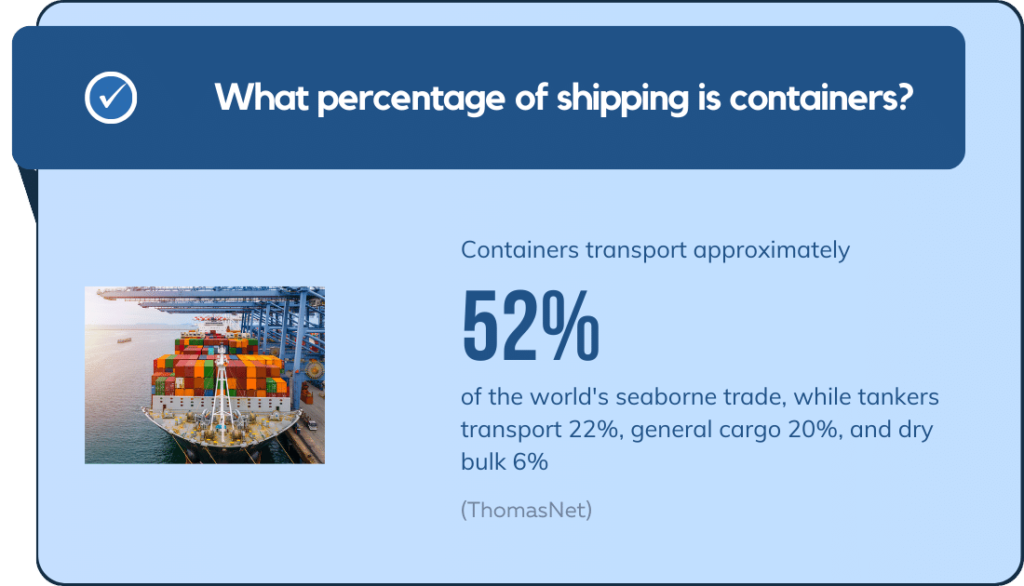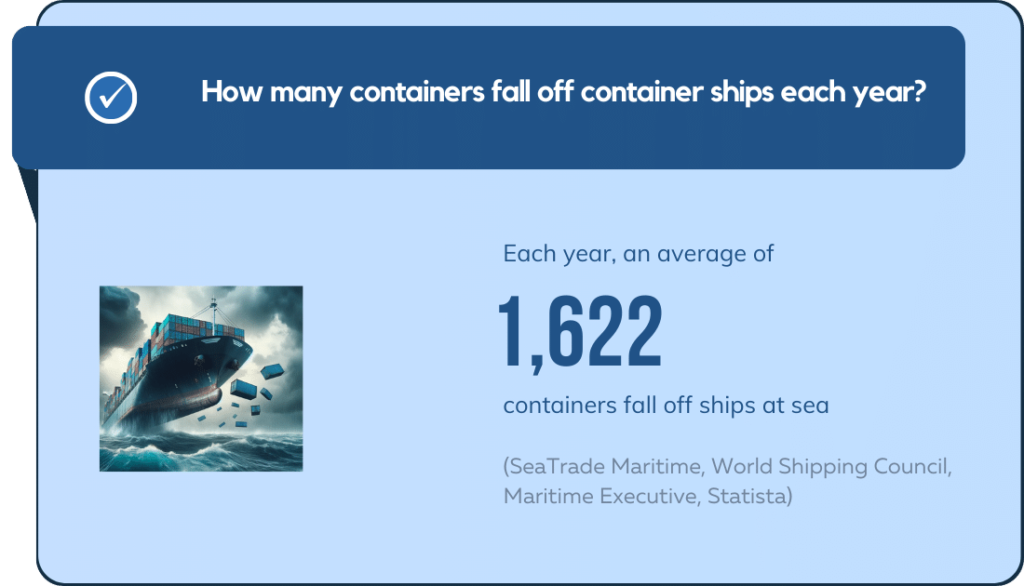Let’s start with some insightful container shipping statistics and facts
Shipping Container Data & Statistics: The Key Findings
- In 2022, the market size was $10.3 billion, and that number is projected to reach 15.87 billion dollars by 2028 globally.
- Containers transport approximately 52% of the world’s seaborne trade, while tankers transport 22%, general cargo 20%, and dry bulk 6%.
- About 1.95 billion metric tons of cargo were shipped globally in 2021.
- Every year, an estimated 799 million shipping containers are shipped, according to average data from three years.
- Each year, an average of 1,622 containers fall off ships at sea.
- Between 1980 and 2020, the deadweight tonnage of container ships has grown from about 11 million metric tons to roughly 275 million metric tons.
- More than 60% of the world’s consumer goods are transported via shipping containers, worth nearly 14 trillion dollars.
Source: (UNCTAD, Statista, PR Newswire, reuters)
Global Shipping Container Market Set to Hit $15.87 Billion by 2028
In 2022, the global market was valued at $10.3 billion, with projections indicating a rise to $15.87 billion by 2028. This big increase is due to changing market forces, better technology, and higher demand in many areas. It has a big effect on the economy and changes in industry trends.
| What Does Data Suggest | Details |
| Rapid Market Growth | Indicates a strong, upward trajectory in market expansion. |
| Influence of Technological Advancements | Suggests a key role for innovation and tech in market development. |
| Increasing Global Demand | Reflects growing consumer and industrial needs globally. |
| Evolving Industry Trends | Points to changing trends and adaptability in the industry. |
Source:PR Newswire
What percentage of shipping is containers?
The majority of global shipping is done via containers. Container ships transport about 90% of all non-bulk cargo worldwide. The global shipping container market was valued at $6.41 billion in 2020, and containers make up 52% of the world’s seaborne trade.

With globalization leading to increased international trade, the demand for container shipping continues to grow. Containerization has revolutionized shipping by improving efficiency and reducing costs. The standardization of container sizes has been critical to the dominance of container shipping.
| What Does Data Suggest | Details |
| Prevalence of Container Shipping | Container shipping dominates, facilitating efficient global trade. |
| Significant Role of Tankers | Tankers, vital for liquid cargo, constitute a fifth of seaborne trade. |
| Importance of General Cargo | General cargo remains crucial, offering versatility in shipping. |
| Lesser Role of Dry Bulk | Dry bulk, though smaller in proportion, is essential for specific commodities. |
How many containers fall off container ships each year?
Annually, an average of 1,622 containers are lost at sea, a concerning statistic that highlights the challenges and risks associated with maritime shipping.

This figure underscores the importance of safety measures, secure container handling, and the need for improved maritime practices to mitigate these losses.
| What Does Data Suggest | Details |
| Maritime Shipping Risks | Indicates inherent risks and challenges in maritime transport. |
| Need for Enhanced Safety Measures | Calls for improved safety protocols and container securing. |
| Environmental and Financial Implications | Highlights potential environmental and economic impacts. |
| Importance of Robust Maritime Regulations | Underlines the need for stricter maritime safety regulations. |
Container Shipping Volume Statistics
Every year, approximately 799 million shipping containers are transported globally. The majority of world trade, around 70%, is carried by sea. Over half of global seaborne trade, or an estimated 52%, moves in shipping containers. The global fleet of container ships has a capacity of nearly 25 million twenty-foot equivalent units (TEUs). Major shipping routes include Asia to North America and Europe. While shipping is efficient, accidents happen, and on average, around 1,622 containers are lost at sea annually.
| What Does Data Suggest | Details |
| Massive Scale of Container Shipping | Demonstrates the vastness and efficiency of containerized trade. |
| Key Role in Global Supply Chain | Container shipping is a backbone of the global supply chain. |
| Standardization in Cargo Transport | Reflects the success of standardized container systems in logistics. |
| Implications for Port and Infrastructure | Suggests significant demand for port and logistical infrastructure. |
2020 Sees Global Shipment of 1.95 Billion Metric Tons of Cargo
Global seaborne trade recovered in 2021 after contracting in 2020 due to the COVID-19 pandemic. Around 1.95 billion metric tons of cargo were shipped globally in 2021, up from 1.32 billion tons in 2020 but still below pre-pandemic levels of 2.01 billion tons in 2019. The majority of maritime freight is dry cargo, which accounted for about 8 billion tons or 73% of the 11 billion tons of total seaborne trade in 2021. Developing Asian economies like China remain the largest contributors, loading and unloading 55% and 61% of global maritime freight respectively. However, developed economies had a trade surplus while developing economies had a deficit in 2021, a reversal from previous years.
| Prioritize the modernization of freight infrastructure | The sheer volume of global cargo underscores the need for efficient, resilient freight networks |
| Enhance regulatory measures for freight weight | With this massive cargo weight, regulations must effectively manage load limits and safety |
| Invest in carbon-neutral freight technologies | Given the scale of cargo shipping, sustainability should be an urgent concern |
Source:Statista
Container Ships’ Deadweight Tonnage Skyrockets from 11M to 275M, 1980-2020
Important takeaway:
| Invest in infrastructure for larger container ships | The increase in deadweight tonnage signifies a demand for bigger, more robust port infrastructure |
| Focus on regulations for heavier ships | With heavier vessels, there’s a need for stringent safety and load management policies |
| Prioritize sustainability in shipping technology | The large growth in shipping weight suggests a significant environmental impact |
The dramatic increase in the deadweight tonnage of container ships from 1980 to 2020 indicates a need for advanced port infrastructure, stringent regulations for heavier ships, and a greater focus on sustainable shipping technologies. These actions can help address the challenges of this expanding sector.
Source:Statista
Shipping Containers Carry 60% of World’s Consumer Goods, Totalling $14 Trillion
More than 60% of the world’s consumer goods are transported via shipping containers, collectively valued at nearly 14 trillion dollars. This impressive statistic highlights the immense value and volume of goods moving through global supply chains, showcasing the critical role of container shipping in the world economy.
| What Does Data Suggest | Details |
| Dominance of Container Shipping | Container shipping is vital for global consumer goods movement. |
| High Economic Value of Shipped Goods | Reflects the substantial monetary value of containerized goods. |
| Influence on Global Trade | Indicates a strong influence on international trade patterns. |
| Importance of Reliable Supply Chains | Underlines the need for efficient and reliable supply chains. |
Source: Reuters